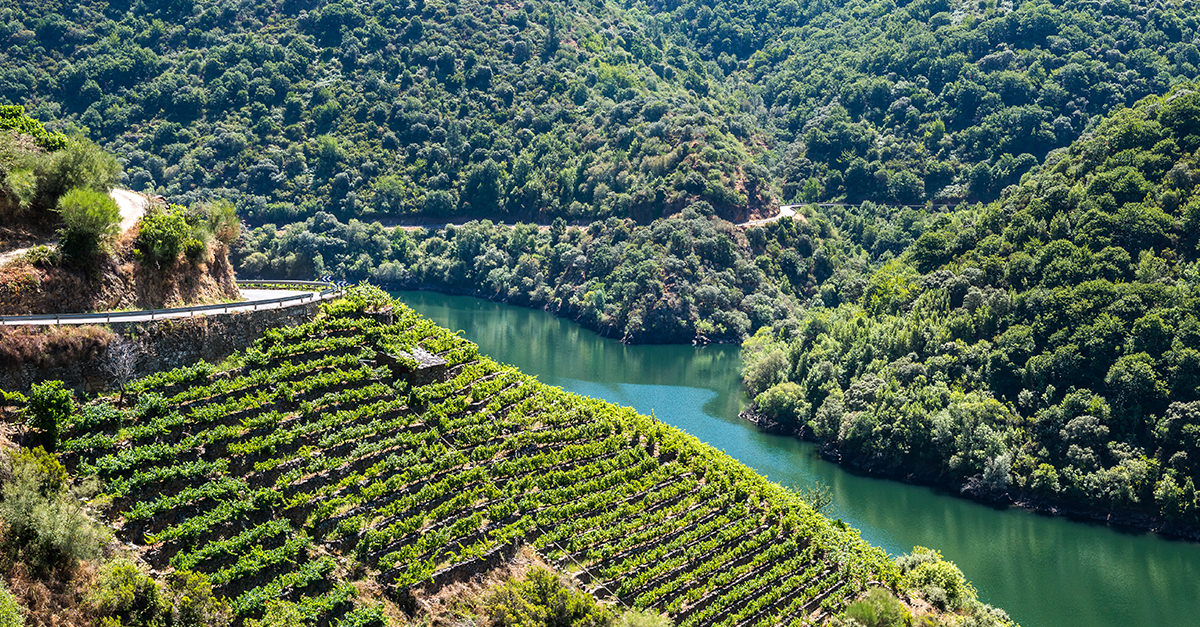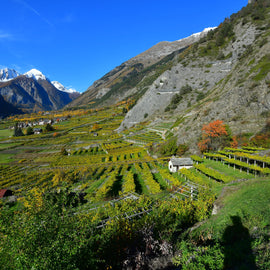If you’ve been a member of one or more of our wine clubs for more than a few months, you’d be forgiven for reading the labels on these bottles and wondering Espagne? Otre Vez? After all, this very club visited in July and the Red Rogues folks were there last quarter (some of you probably saw each other and waved!). You already know and love Rioja, the north central region synonymous with plush and fruity reds made from mostly Tempranillo and aged in American oak. You also might also be familiar with Ribera del Duero and Toro, the two other regions that produce their own lovely and distinctive wines from Tempranillo. Then there’s Priorat in southwestern Catalonia, prized for full bodied, high-alcohol red blends made from the singular local iron-rich black slate and quartz known as llicorella; Sherry, the fortified wine with enough variations to constitute it’s own subject (holler if you’d be interested in a Sherry club); and Cava, like Champagne but more affordable and made with Iberinan grapes. Then there’s Albarino, Godello, etc, etc…
What’s incredible is that you could feast your way through each of these places and still not reach Spain’s last course (though you might have trouble getting up from the table). There is still a bunch of Spainsplaining (sorry) left to do – and this month it concerns Galicia, maybe the most exciting place for wine in the whole country right now and probably the most diverse. Occupying the far northwest corner, bordering Portugal to the south, the Atlantic to the north and west, and mountain ranges to the east, Galicia is the wettest region in the country (the rain in Spain falls mainly here). Visitors are often surprised to find a lush green landscape closer to the Emerald Isle ideal than southern Europe. This is especially true along the coast, where the region’s most famous DO, Rias Baixas, is located. Created in 1988, it is divided into 5 subareas - from north to south: Ribeira do Ulla, Val do Salnés, Soutomaior, Condado do Tea and O Rosal. The white grape Albarino is the most important varietal but the region is home to 13 more natives varieties, 5 other whites: Loureira blanca, Treixadura, Caiño Blanco, Torrontés and Godello; and 8 reds: Caiño tinto, Castañal, Espadeiro, Loureira tinta, Sousón, Mencía, Brancellao and Pedral. Our red this month is Mencia from the Val do Salnes subregion which is responsible for 60% of the DO’s entire production. Mencia is Spain’s rough Pinot Noir analogue, and it produces a light–to-medium red wine with a generous fruit and a a distinctive herbaceous overlay. Most Mencia comes from other parts of Galicia, the DOs of Bierzo and Ribeira Sacra in particular. It is a rare treat to find one from Rias Baixas that displays the area’s characteristic acidity and saline minerality while retaining the varietals most recognizable traits.
Our white is a blend from the Ribeira DO (which is distinct from the aforementioned Ribeira del Duero and Ribeira Sacra designations), south of Rias Baixas and a little more inland. Established in 1932, it is the oldest DO in Galicia, and occupies the confluences of the valleys formed by the rivers Miño, Avia and Arnoia. It is still close enough to the Atlantic (45 km) to make it a climactic transition zone. It is protected from harsh coastal weather conditions by a range of mountains, but still benefits from ocean breezes and precipitation proximity. This allows the grapes to fully ripen and develop a floral, aromatic complexity while keeping the mouthwatering freshness that Galician wines are known for. In the local dialect 'ribeiro' means riverbank and water is a key element of the area with the best vineyards planted on the steep slopes of the rivers that converge here. Antonio Montero’s ‘Autor’ bottling is mostly (80% ) Treixadura, the most prestigious white grape in the region, presented here, as it usually is, with small amounts of Ribeiro's other white grapes: Torrontés, Loureira, and Albariño.
Cheers,
The PlumpJack Wine Team
|
Region / Country of Origin:Val do Salnés, Rías Baixas, Spain |
About the winery: Casa Monte Pio was founded in 1979 by Jose María Martinez; now his grandson Pablo Martinez carries the family tradition as the owner and winemaker. Pablo’s passion lies in the vineyard – he realized this after a brief career in accounting. Upon his return to the wine industry, he has dedicated himself to organic viticulture and craft wine production. His vineyards are located within walking distance to their family home, located in the heart of the Val do Salnès near the Rio Umai. About the winemaking: 100% Mencia. Grapes from a single plot 200m above sea level with soils of decomposed granite near the village of Ribadumia. The area has a maritime climate, with hot summers and high levels of humidity. Hand harvested and carefully selected, the grapes were destemmed and drawn-off by gravity. Then the wine was fermented in stainless steel tanks and aged in French oak barrels for 9 months. Aged in bottle for an additional few months before release. Tasting Notes: Appearance: Bright cherry red. Nose: Red and wild fruits, slightly spiced with a mineral background. Taste: Fresh with a great fruit load, long finish with floral and vegetal notes. |
|
Winemaker: Pablo Martinez |
|
|
Price: $27 btl/$291.60 case |
|
|
Suggested Food Pairing: Cured and gamey meats Branzino, Mushroom Risotto, Portabello Mushroom Steak, tomato dishes and lentils, bell peppers, olives and artichokes. Hard and sharp cheeses like cheddar and manchego. |
|
|
Region / Country of Origin:, Riberia, Galicia, Spain |
About the Winery: Antonio Montero’s winery was established three generations ago and is located in the heart of the Ribeiro DO, 45km east from the Atlantic Ocean in Galicia. All the labor in the vineyards is done manually, with the vines being on hillsides and small plots. The use of terraces (known locally as socalcos or bocaribeiras) is common in the Ribeiro DO as the slopes can be very steep. The main vineyards are on the slopes of ‘Coto de Novelle’ on the left bank of the Miño river, as well as as a bunch of small plots such as ‘A Ponte’, ‘O Quinteiro’, ‘Fonte Quente’, ‘La Calzada’ etc. The soil is mostly clay and sand but with variations from plot to plot. About the winemaking: Fermentation in stainless steel tanks under controlled temperature. We keep the wine with the lees during 4- 5 months. Stabilization by refrigeration Tasting Notes: Clean and brilliant, yellowish straw-covered color with greenish and golden highlights. Complex aroma of white fruits, dairy products, citrus and menthols. The mouthfeel is wide, structured and filling. Great long final persistence. Very good balance between alcohol and acidity, that provides roundness and warmth. |
|
Winemaker: Antonio Montero / Julio Ponce |
|
|
Price: $22 bottle / $237.60 case |
|
|
Suggested Food Pairing: Red Peppers Stuffed with cheese Seared Scallops and Herb Octopus salad |
|





